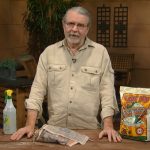Why apply compost in winter?
While compost may be applied any time of year, winter is the best time to apply large amounts when plants are dormant. Compost is 100% organic matter and needs a little time to be broken down by microbes and become a part of your garden soil. That microbial action turns the compounds that are tied up in that organic matter into precious, slow-release nutrients for your plants.
But more importantly, that organic matter will become a part of your soil as it’s broken down, slowly, making for better soil structure, and a better environment for most plants’ roots, over time. Better soil structure means better water and nutrient holding capacity, as well as better oxygen exchange. And that is a good thing for many plants, both ornamental and vegetable.
You can add compost as mulch in garden beds around established plants any time of year, but adding a 1 to 3 inch layer in the winter allows for a slower breakdown, and is just a good all-around practice. Putting this task on your annual garden to-do list will make a difference, over time, in the health of your soil, and will provide enough nutrients for most native plants.
Note: compost isn’t a universally good thing. If you have plants that prefer sandy or even rocky soil, or if you have succulents that are recommended to be planted on berms or extremely loose soil, those areas of your garden could actually be hampered by the addition of compost, so be judicious.

 Elayne Lansford
Elayne Lansford John Dromgoole
John Dromgoole